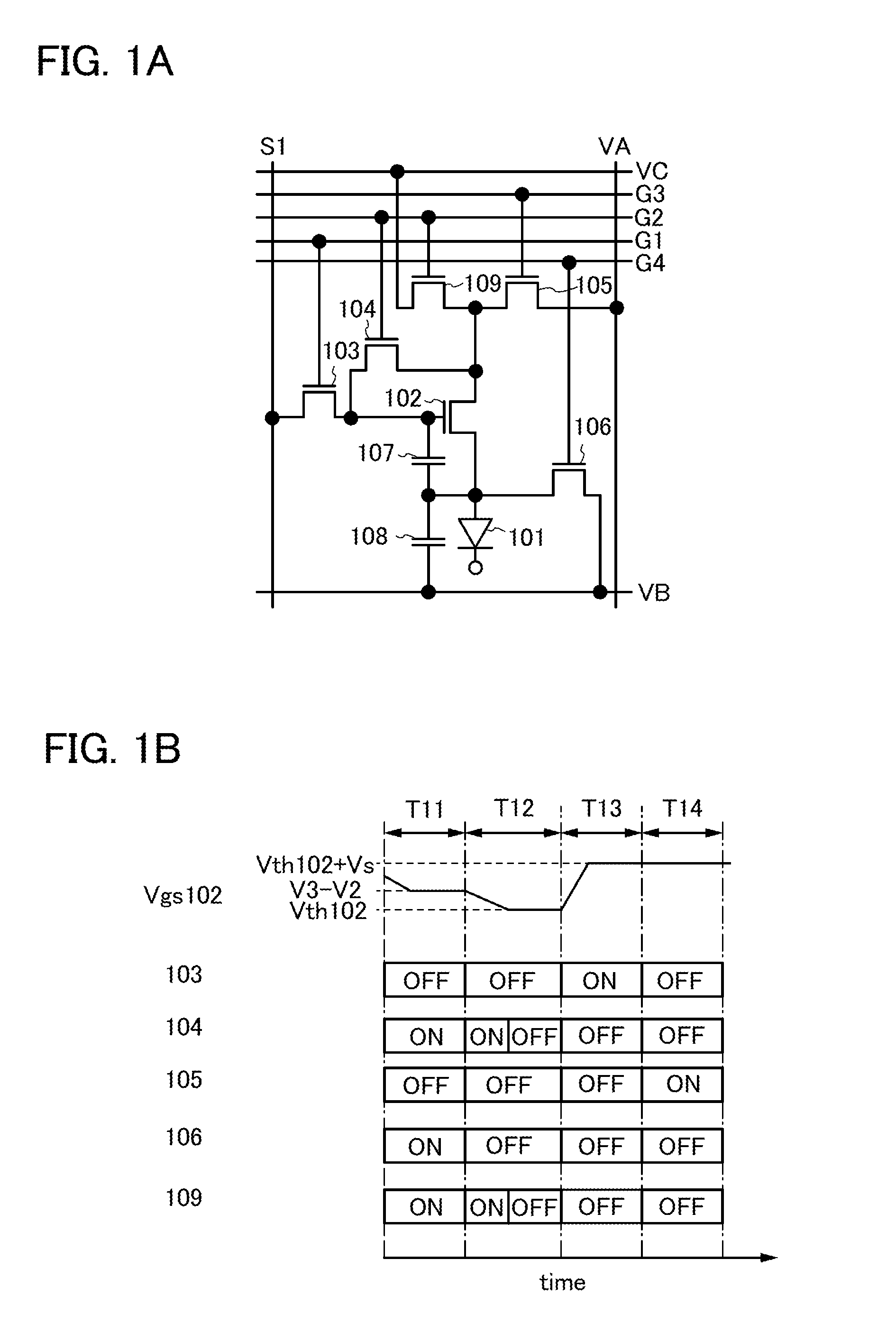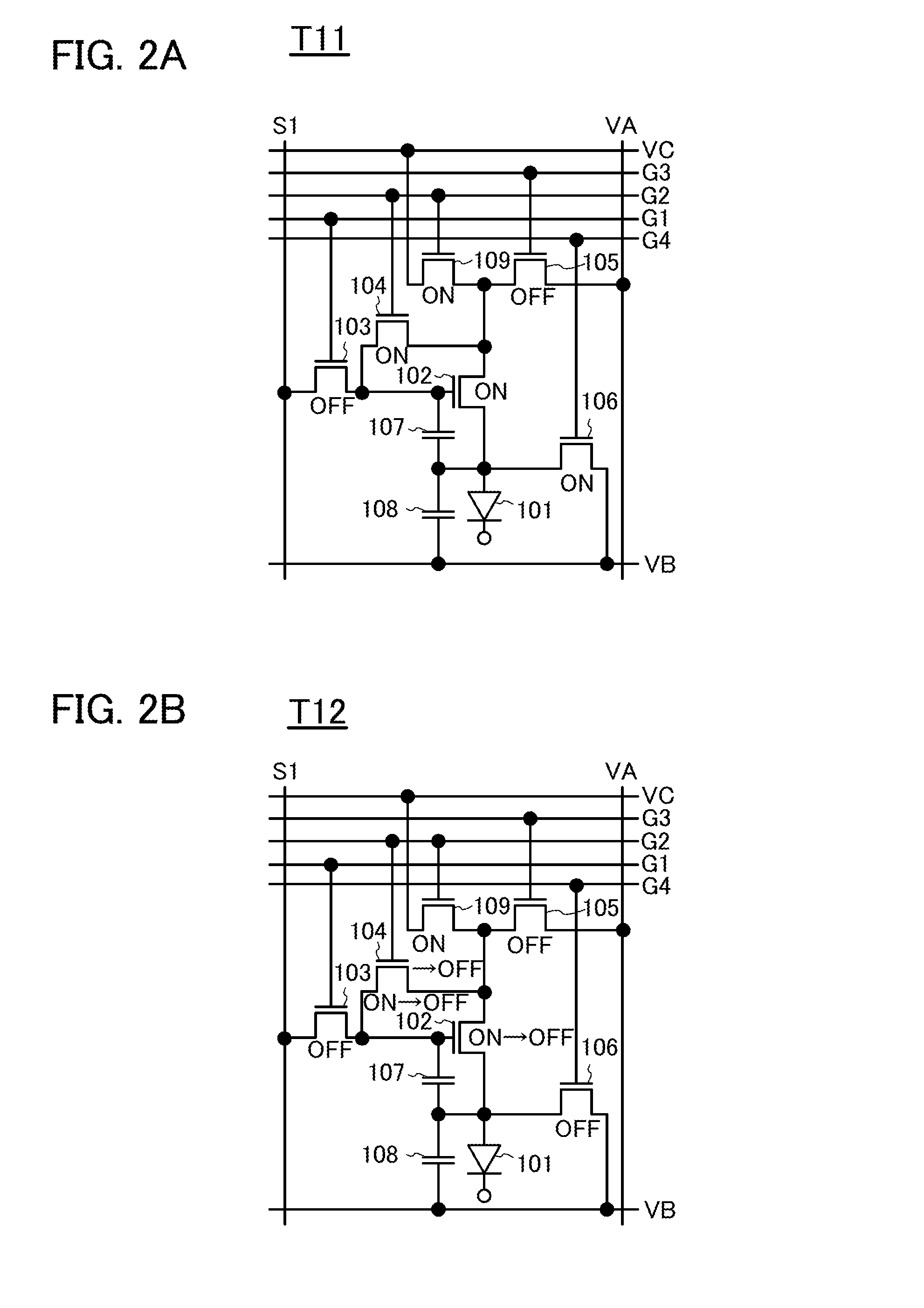Light-emitting device
a technology of light-emitting devices and electroluminescent layers, which is applied in the direction of static indicating devices, solid-state devices, instruments, etc., can solve the problems of sputtering damage to the electroluminescent layer, and suppress the luminance variation among pixels caused by the threshold voltage variation of driving transistors, so as to reduce the luminance of light-emitting elements caused by deterioration of electroluminescent layers.
- Summary
- Abstract
- Description
- Claims
- Application Information
AI Technical Summary
Benefits of technology
Problems solved by technology
Method used
Image
Examples
embodiment 1
[0048]A light-emitting device in this embodiment includes a pixel portion. An example of the pixel portion in the light-emitting device in this embodiment will be described with reference to FIGS. 1A and 1B.
[0049]As illustrated in FIG. 1A, the pixel portion includes a signal line S1, a power supply line VA, a power supply line VB, a power supply line VC, a scan line G1, a scan line G2, a scan line G3, a scan line G4, a light-emitting element 101, a transistor 102, a transistor 103, a transistor 104, a transistor 105, a transistor 106, a capacitor 107, a capacitor 108, and a transistor 109.
[0050]In the light-emitting device in FIG. 1A, the transistors are field-effect transistors. A source and a drain of each transistor are interchanged in some cases depending on a structure or operation conditions of the transistor.
[0051]For example, one pixel may be constituted by one pixel circuit including the light-emitting element 101, the transistor 102, the transistor 103, the transistor 104,...
embodiment 2
[0088]In this embodiment, a specific structure of a pixel of a light-emitting device according to one embodiment of the present invention will be described.
[0089]FIG. 5 illustrates an example of a top view of the pixel illustrated in FIG. 1A. Note that in the top view of the pixel in FIG. 5, various insulating films are omitted in order to clearly show the layout of the pixel. Further, in the top view of the pixel in FIG. 5, the anode, the electroluminescent layer, and the cathode are omitted in order to clearly show the layout of the transistors and the capacitors included in the pixel.
[0090]FIG. 6 is a cross-sectional view taken along dashed lines A1-A2 and A3-A4 in the top view in FIG. 5.
[0091]The transistor 103 includes, over a substrate 800 having an insulating surface, a conductive film 801 functioning as a gate, a gate insulating film 802 over the conductive film 801, a semiconductor layer 803 positioned over the gate insulating film 802 to overlap with the conductive film 80...
embodiment 3
[0211]In this embodiment, an example of a specific structure of a light-emitting device according to one embodiment of the present invention will be described. In FIG. 11, a block diagram of a light-emitting device in this embodiment is shown as an example. Note that in the block diagram in FIG. 11, circuits in the light-emitting device are classified according to their functions and are illustrated as separated blocks. However, it is difficult to classify actual circuits according to their functions completely and one circuit may have a plurality of functions.
[0212]The light-emitting device shown in FIG. 11 includes a pixel portion 500 including a plurality of pixels, a scan line driver circuit 510 which selects pixels per line, and a signal line driver circuit 520 which controls an input of an image signal to the pixels in the selected line.
[0213]The structure of the pixel portion 500 can be, for example, the structure of the pixel portion in the light-emitting device described in...
PUM
 Login to View More
Login to View More Abstract
Description
Claims
Application Information
 Login to View More
Login to View More - R&D
- Intellectual Property
- Life Sciences
- Materials
- Tech Scout
- Unparalleled Data Quality
- Higher Quality Content
- 60% Fewer Hallucinations
Browse by: Latest US Patents, China's latest patents, Technical Efficacy Thesaurus, Application Domain, Technology Topic, Popular Technical Reports.
© 2025 PatSnap. All rights reserved.Legal|Privacy policy|Modern Slavery Act Transparency Statement|Sitemap|About US| Contact US: help@patsnap.com



